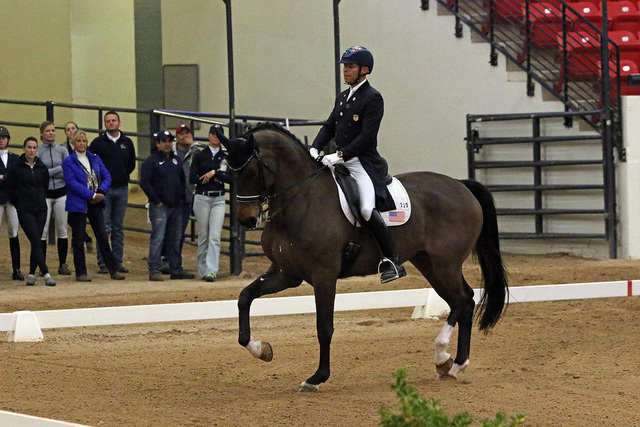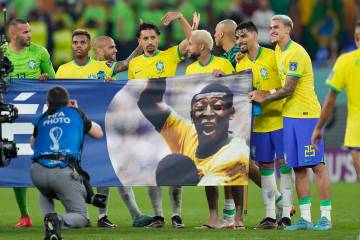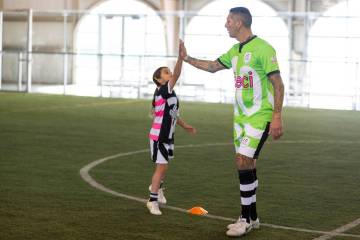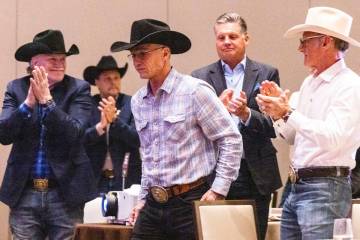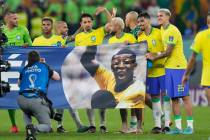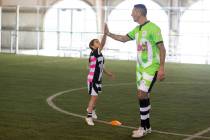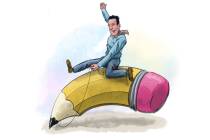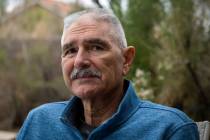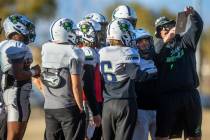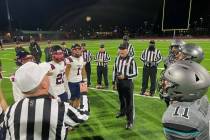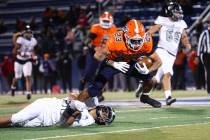Olympic bronze medalist Steffen Peters struts his stuff in South Point dressage arena
A two-time Olympic bronze medalist competed in obscurity in Las Vegas on Saturday, which sometimes happens on the first weekend of the NFL playoffs.
Would it have been different had he won gold? Probably not.
While patrons were stacked about the televisions in the South Point Race and Sports Book, a slight man sporting a navy cap adorned with stars and stripes, black competition coat, white gloves, knee-high black boots and a calm demeanor named Steffen Peters — and his steed, a 10-year-old Rhinelander mare named Rosamunde — got in sync in the ancient sport of dressage in the equestrian arena upstairs.
To the uninitiated, dressage sounds like one of those sniglets — combine a prom dress with a corsage, you get a dressage. But the French term meaning “training” traces its equine origin to the 1550s. To compare it to a sniglet probably borders on blasphemy.
With all respect due D. Wayne Lukas and Lucien Laurin, who trained the mighty thoroughbred Secretariat, it is dressage that is defined as “the highest expression of horse training” by the International Equestrian Federation.
In horse racing after training of a high expression, there also is a furious pounding of hoofs. And if it’s raining, the jockey gets mud in his eye. Unless it’s one of those wire-to-wire jobs, a la Secretariat in the 1973 Belmont Stakes.
In dressage, in lieu of fury there is artful expression. The horses are impeccably groomed. They strut and prance and preen like John Travolta in “Saturday Night Fever.”
This is how it was explained: In modern dressage, successful training is demonstrated through the performance of “tests” — prescribed movements of horse and rider within the arena. Most movements are performed by the horse; one almost doesn’t notice the rider, at least not in the way one would notice Laffit Pincay Jr. or Gary Stevens spinning out of the turn and racing for home.
In dressage, judges evaluate each movement and assign a score of zero to 10. There are five judges stationed around the arena between potted plants and flowers. All sixes is satisfactory; nines are very good; a 10, unlike in gymnastics, has never been awarded. Not even by a French judge.
Steffen Peters and Rosamunde, his new mount, won the inaugural High Roller Grand Prix Freestyle at the South Point with an average score of 78.425. Apparently, dressage judges are more difficult to impress than Robert Duvall’s character in “The Great Santini.”
Afterward, I was told Rosamunde made a mistake during a 1-tempi change. How did I miss it?
Down in the warmup area beneath the saloon, Steffen Peters, who was born in Germany but became a naturalized American citizen in 1985 and operates a California training facility not far from where the surf meets the turf at old Del Mar Fairgrounds near San Diego, was kind enough to explain his sport in terms that even I could understand.
He used football expressions.
“It was like throwing a rookie quarterback into the playoffs,” the affable 52-year-old equestrian said of stablemate and protege Dawn White-O’Connor, who finished second aboard Legolas, the 15-year-old Westfalen her mentor rode in leading the U.S. to the bronze medal in Rio de Janeiro five months ago.
Peters, who spoke highly of the South Point setup — “Truly an international venue, it’s just fantastic ” — said some dressage movements emanate from battle applications in the Middle Ages. “So we’ve come a little bit further than that. The sport has progressed. Basically, it’s ballet on a horse.”
It certainly is, and I have heard patrons of the arts sometimes are moved to tears during “The Nutcracker” and “Swan Lake.”
When Steffen Peters rode Rosamunde into the arena after being introduced by the public address announcer with the staid British accent, lush orchestral interpretations of Coldplay and U2 tunes began to waft from the speakers. The two strutted and pranced and preened in step to the music, making the highest expression of horse training look effortless.
When I turned to determine how the woman sitting alongside felt about the ancient sport of dressage, there was a tear in her eye.
Contact Ron Kantowski at rkantowski@reviewjournal.com or 702-383-0352. Follow @ronkantowski on Twitter.
Steffen Peters is one of the most successful dressage competitors in U.S. history. A look at how he has fared in international competition:
Olympic Games
— 1996 Atlanta; bronze medal, team dressage
— 2016 Rio de Janeiro; bronze medal, team dressage
Pan American Games
— 2011 Guadalajara, Mexico; gold medal, individual and team dressage
— 2015 Toronto, gold medal, individual and team dressage
World Championships
— 2006 Aachen, Germany; bronze medal, team dressage
— 2010 Lexington, Kentucky; bronze medal, special dressage, freestyle dressage



